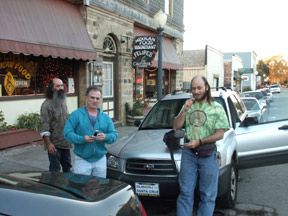 Our
tiny crew outside Felipe's.
Our
tiny crew outside Felipe's.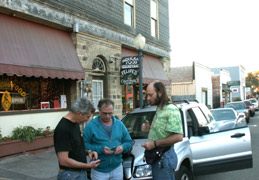
Nov 13/14, 2004
With a weak El Nino dominating weather this Fall, it's been hard to find clear nights. But Saturday Nov 13 seemed to be just barely wedging in between two cold fronts and clear skies looked like they may hold till early Sunday morning. Unfortunately, the Cabrillo web server went down on Friday and it was not possible to update the web page giving a "go" for this trip. Karl and I decided to give it a try. Tom and Karl drove together, and Erik from 9A also joined us. We met at Felipe's as planned, had a nice Salvadorean dinner, and waited for more students who might show, before taking off at 4:30pm.
 Our
tiny crew outside Felipe's.
Our
tiny crew outside Felipe's.
Tuning our walky-talkies to channel #1 for the caravan south.
Our site was at the top of the mountains above Mercey Hot Springs, with wide views in all directions. We could see fog or moisture concentrated in the air layer just below our elevation, but at our site we had beautiful dark skies and not much trouble with dew.
The photos below are all taken with our Dimage 5 digital camera, at 30 seconds, wide open (f3.5) and wide-angle.
I set up and polar-aligned the GM8 mount and platform with ball-head camera
mounts for wide angle photography. 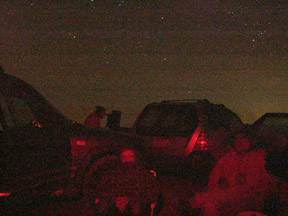 Here,
Erik in the background is manually guiding his 8" scope piggybacking for
his Nikon DX70 digital camera. Karl and Tom are in the foreground; lounging
in beach chairs while the GM8 does all the tracking work. Note the Hydades and
Aldebaren in the upper right.
Here,
Erik in the background is manually guiding his 8" scope piggybacking for
his Nikon DX70 digital camera. Karl and Tom are in the foreground; lounging
in beach chairs while the GM8 does all the tracking work. Note the Hydades and
Aldebaren in the upper right.
I also set up 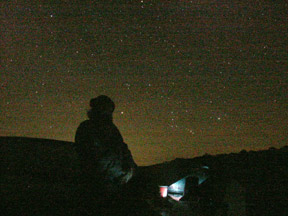 the
stove and brought along hot chocolate (kinda gummy low-carb stuff from Trader
Joe's, but it was hot at least). Karl on the right is lit by the stove glow
with Orion rising in the distance.
the
stove and brought along hot chocolate (kinda gummy low-carb stuff from Trader
Joe's, but it was hot at least). Karl on the right is lit by the stove glow
with Orion rising in the distance.
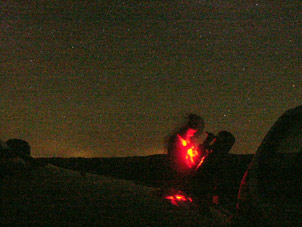 Erik
guides manually at his 8", using his digital Nikon D70 to capture images.
Erik
guides manually at his 8", using his digital Nikon D70 to capture images.
Next target was the California Nebula 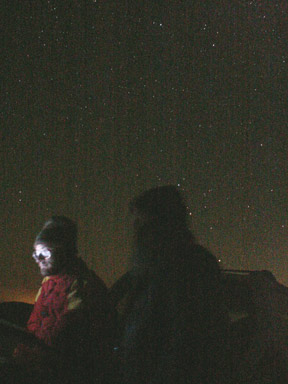 in
Perseus, but the small field of view required knowing exactly where the nebula
was (it's too faint to see visually), so Erik gets out the laptop and software
to find the location.
in
Perseus, but the small field of view required knowing exactly where the nebula
was (it's too faint to see visually), so Erik gets out the laptop and software
to find the location.
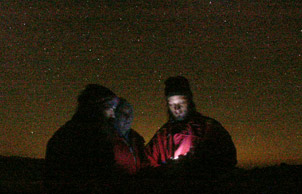 The
result was impressive! 5 minutes captured a decent image of the red California-shaped
emission region. Erik's showing the picture on the LCD screen to Karl and Tom
at left. Below, Karl verifies by checking his own charts. Sirius and Canis Major
is in the background.
The
result was impressive! 5 minutes captured a decent image of the red California-shaped
emission region. Erik's showing the picture on the LCD screen to Karl and Tom
at left. Below, Karl verifies by checking his own charts. Sirius and Canis Major
is in the background.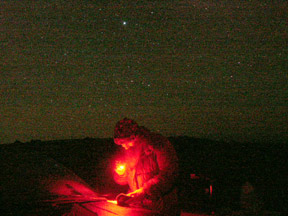
Tom and Karl used the GM8 mount and medium to wide angle lenses. I used the GM8 and shot with my 24mm and 100mm fixed lenses on my OM-1. I borrowed Jay's Olympus varimag which, combined with my new Beattie Intenscreen focusing screen, made focusing even on faint stars very easy and accurate. Infinitely better than trying to focus strictly on the standard screen. I also did quite a number of pictures at 10 and even 15 minutes with the OM-1 at the back end of the Orion Short-Tube. All pictures were un-guided. We were a little uncertain whether the GM-8 was up to the job, but just before quitting Erik put his Nikon DX70 and 300mm lens on the GM8 for a 5 minute picture. We examined the image and used the magnifying feature to see the stars on the frame up close. They were nice and round, so I'm optimistic that we'll have some great pictures to scan and post later. By the time 1:30am arrived, Karl and Tom were out of film and packed up to head back. Erik and I got in another hour before we were ready to call it quits. My subjects consisted of the Veil Nebula, Andromeda Galaxy, Plieades, Orion and Horsehead nebulae. Lots of frames each, for stacking later, and all on Fuji Provia 400F slide film. My only regret is that I forgot all about trying to get Comet Machholz, which was high enough in southern Lepus to get about the time we left.